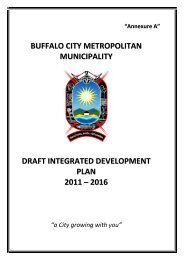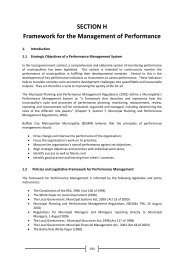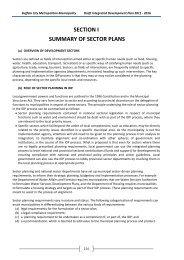annexure d executive summary of bcm sector plans - Buffalo City
annexure d executive summary of bcm sector plans - Buffalo City
annexure d executive summary of bcm sector plans - Buffalo City
You also want an ePaper? Increase the reach of your titles
YUMPU automatically turns print PDFs into web optimized ePapers that Google loves.
INTEGRATED DEVELOPMENT PLAN: REVIEW 2010/11ANNEXURE DThe main identified implications <strong>of</strong> the above strategies for the BC LEDS are as follows:(a) <strong>Buffalo</strong> <strong>City</strong> is classified nationally as having “medium potential” and is therefore not seento be a national development priority, with Coega and Nelson Mandela Metro receivingpriority I terms <strong>of</strong> the allocation <strong>of</strong> national infrastructure funding. This situation existspartly because <strong>of</strong> a lack <strong>of</strong> national understanding regarding the critical importance <strong>of</strong><strong>Buffalo</strong> <strong>City</strong> in servicing a broader regional and rural economy which contains about 4million people. The success <strong>of</strong> the BC and regional economy cannot be separated.(b)(c)International critics <strong>of</strong> the governments industrial development strategy have noted thatits major weakness is its failure to address what are termed “ small industrial policy” issueswhich related to the basic functioning <strong>of</strong> the business environment but which promise tosubstantially undermine the productivity and ease <strong>of</strong> doing business <strong>of</strong> existinginvestors/businesses in South Africa. Issues such as crime, home affairs proceduresregarding visas, government decision-making time-frames, general attitudes <strong>of</strong>government towards business, land availability, transport reliability and local municipalservices as seen to be just as important, if not more so, than big industrial supportprogrammes. This finding represents a major opportunity for <strong>Buffalo</strong> <strong>City</strong> to focus ongetting the basics right and differentiate it business environment from those <strong>of</strong> its bigger<strong>City</strong> competitors by ensuring the existing businesses are treated well and that basicservices and decision-making process are efficient.The focus on addressing constraints to growth needs to be addressed at a local level andthe following opportunities are highlighted: The ASGISA Infrastructure Plan and national budgetary surplus represents a goldenopportunity for <strong>Buffalo</strong> <strong>City</strong> to tap into a massive infrastructure investment phaseafter years <strong>of</strong> neglect. If this does not happen, there is the danger that <strong>Buffalo</strong> <strong>City</strong>will not receive meaningful infrastructure investment required to ensure that itsport, airport, road and rail infrastructure are able to competitively service exportoriented activity. This threatens to undermine the economic sustainability <strong>of</strong> <strong>Buffalo</strong><strong>City</strong>. The EL IDZ will not attract much foreign direct investment if logisticsinfrastructure constraints are not addressed. The BC LEDS proposal must thereforeaddress this issue as well as consider different future economic scenarios for <strong>Buffalo</strong><strong>City</strong>. If logistics infrastructure is not expanded, the focus will need to be onproviding a supportive business environment for domestic investment. If capacity isaddressed, more focus on a foreign investment strategy will be required.National strategies and funds for agriculture, tourism, business process outsourcing,film, clothing and textiles, and automotive <strong>sector</strong>s mean that significant nationalfunds are being spent as well as the provision <strong>of</strong> an increasingly supportiveregulatory environment to accelerate the growth <strong>of</strong> these <strong>sector</strong>s and BC needs todevelop and adequately resource its own local strategies in these <strong>sector</strong>s tocapitalise on these opportunities. The lack <strong>of</strong> provincial strategies as well as <strong>sector</strong>focusedexpertise presents a challenge to <strong>Buffalo</strong> <strong>City</strong> in terms <strong>of</strong> the possiblemarginalisation <strong>of</strong> <strong>Buffalo</strong> <strong>City</strong> in terms <strong>of</strong> initiatives which maximise opportunities inthese <strong>sector</strong>s. The BC CDS does not identify detailed strategies for agriculture,manufacturing or services <strong>sector</strong>s and this is therefore a critical focus <strong>of</strong> the BCLEDS.The focus on advanced manufacturing must be supported, especially with respect toan automotives supplier development programme which assists suppliers toupgrade their technological capabilities.Future tourism growth will depend on a wide range <strong>of</strong> factors includingimprovements in logistics infrastructure, tourism infrastructure (e.g. beach front),branding and marketing and additional resources are required to implement anumber <strong>of</strong> priority initiatives which have already been identified.The increasing focus on regulatory constraints to economic growth must be pulleddown to the local level to inform refinements to priority municipal processes whichconstrain economic development (for example through a Red Tape ReductionProcess as well as through other continuous improvement processes).
















